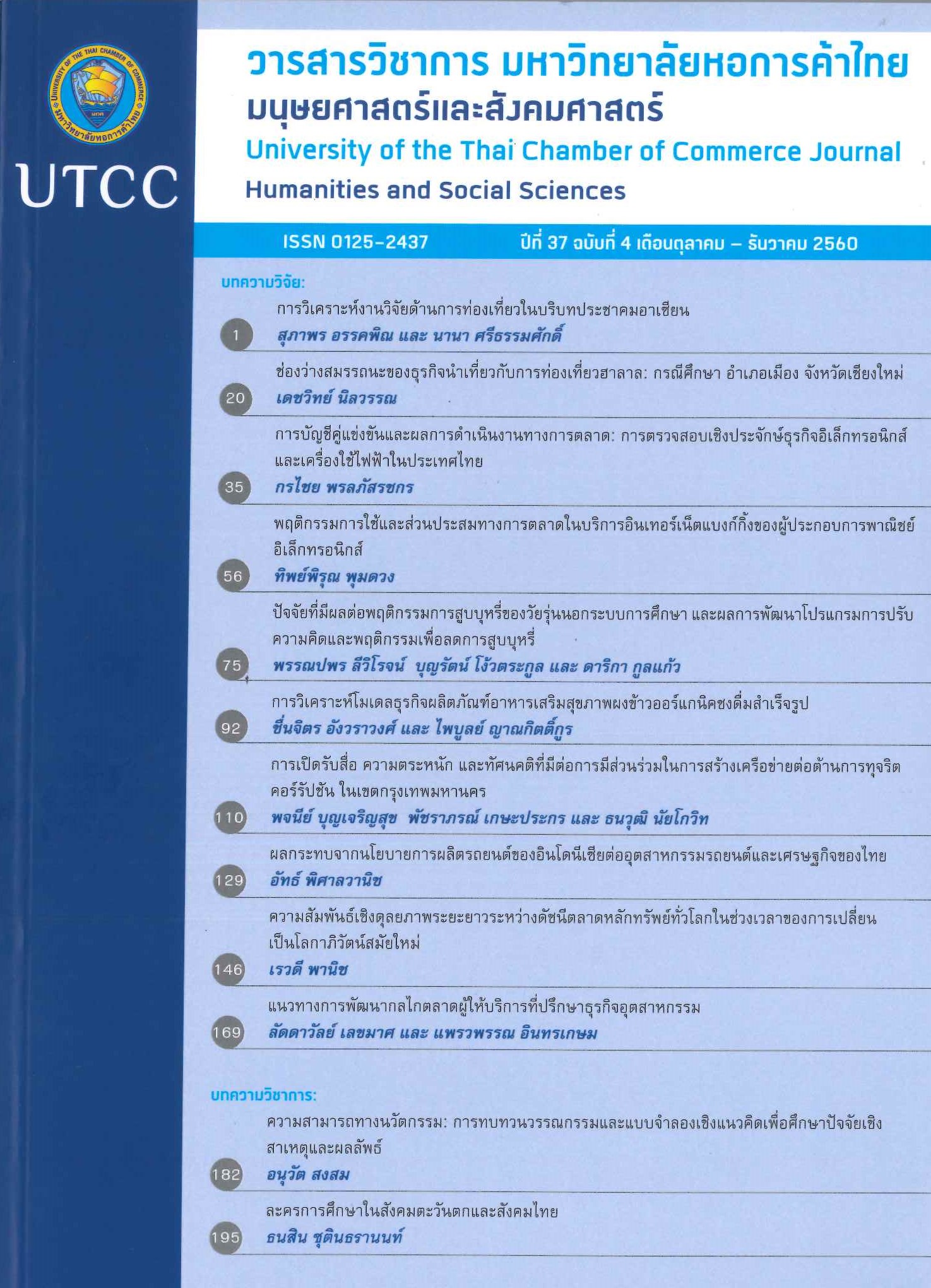ปัจจัยที่มีผลต่อพฤติกรรมการสูบบุหรี่ของสัยรุ่นนอกระบบการศึกษา และผลการพัฒนาโปรแกรมการปรับความคิดและพฤติกรรมเพื่อลดการสูบบุหรี่
Main Article Content
บทคัดย่อ
การวิจัยนี้มีวัตถุประสงค์เพื่อศึกษาปัจจัยที่มีผลต่อพฤติกรรมการสูบบุหรี่ และผลการพัฒนาโปรแกรมมการปรับความคิดและพฤติกรรมเพื่อลดการสูบบุหรี่ ในกลุ่มวัยรุ่นนอกระบบการศึกษา โดยใช้วิธีการวิจัยแบบผสานเป็นระยะ ประกอบด้วยวิธีการสำรวจและการวิจัยเชิงทดลอง และนำผลการศึกษามาใช้ในการพัฒนาโปรแกรมปรับความคิดและพฤติกรรมเพื่อลดการสูบบุหรี การวิจัยสำรวจในระยะแรกรวบรวมข้อมูลด้สยแบบสอบถามจากกลุ่มตัวอย่างวัยรุ่น จำนวน 600 คน ด้วยการคัดเลือกแบบหลายขั้นตอน ได้กลุ่มตัวอย่างที่สูบบุหรี่นอกระบบการศึกษา จำนวน 91 คน ส่วนการวิจัยเชิงทดลอง รวบรวมข้อมูลจากกลุ่มตัวอย่างที่ได้คัดเลือกจากแบบทดสอบการติดบุหรี่ (Fagerstorm test for nicotine dependence: FTND) ระดับคะแนน 4-5 แสดงว่าเป็นผู้ที่มีพฤติกรรมการสูบแบบเสี่ยง จำนวน 34 คน และคัดเข้าเป็นกลุ่มตัวอย่าง จำนวน 20 คน เป็นกลุ่มทดลอง จำนวน 10 คน และกลุ่มควบคุม จำนวน 10 คน มีการทดสอบก่อนการทดลอง หลังการทดลองและระยะติดตามผลการทดลอง การวิเคราะห์ข้อมูลด้วยสถิติเชิงพรรณาและการวิเคราะห์สมการถดถอยเชิงพหุ (Multiple Regression Analysis) และการทดสอบทางสถิติตัวที (t-test) ผลการศึกษา พบว่า ปัจจัยครอบครัวและสังคมยอมรับการสูบบุหรี่ที่มีผลต่อการสูบบุหรี่ จึงได้นำตัวแปรนี้ไปพัฒนาโปรแกรมในการศึกษาในระยะที่ 2 โปรแกรมที่ได้จากการพัฒนาเป็นการนำปัจจัยครอบครัวและมาตรฐานทางสังคม ร่วมกับกระบวนการปรับความคิด (Congnitivice Behavior Therapy) ของ Beck (1967) และลักษณะมุ่งอนาคต ประกอบด้วย 3 ขั้นตอน 8 กิจกรรม จำนวน 8 ครั้ง ๆ ละ 60-90 นาที สัปดาห์ละ 1 ครั้ง รวม 8 สัปดาห์ ผลการศึกษา พบว่า ภายหลังการทดลองโปรแกรม CBT เพื่อลดการการสูบบุหรี่ที่สร้างขึ้นนั้น สามารถลดพฤติกรรมการสูบบุหรี่ได้
Article Details
ลิขสิทธิ์ของบทความ
ผลงานที่ได้รับการตีพิมพ์ถือเป็นลิขสิทธิ์ของมหาวิทยาลัยหอการค้าไทย ห้ามมิให้นำเนื้อหา ทัศนะ หรือข้อคิดเห็นใด ๆ ของผลงานไปทำซ้ำ ดัดแปลง หรือเผยแพร่ ไม่ว่าทั้งหมดหรือบางส่วนโดยไม่ได้รับอนุญาตเป็นลายลักษณ์อักษรจากมหาวิทยาลัยหอการค้าไทยก่อน
เอกสารอ้างอิง
Beck, T. (1995). Cognitive therapy: Basics and beyond. New York, NY: Guilford Press.
Beck, T. (1967). Depression: Clinical, experimental and theoretical aspects. New York, NY: Haper & Row.
Center for Disease Control and Prevention. (2015). Smoking and tobacco use: Fast facts. Retrieved June 12, 2016, from https://www.cdc.gov/tobacco/data_stati
Department of Disease Control, Office of Tobacco Control. (2017). Tobacco products control act (2017). Bangkok, Thailand: Thammasat printing house. (in Thai).
Department of Disease Control, Office of Tobacco Control. (2016). Tobacco consumption control situation in Thailand. Bangkok, Thailand: Thammasat printing house. (in Thai).
Doubeni, M. D., Wenjun, L., Hassan, M. S., & Difranza, R. (2008). Perceived accessibility as a predictor of youth smoking. Ann Family Medicine, 6(4), 323-330.
Edmonds, W. A., & Kennedy, T. D. (2013). An applied reference guide to research designs. Los Angeles, CA: SAGE.
Fagerstrom, K. (1978). Measuring degree of physical dependence to tobacco smoking with reference to individualization of treatment. Addictive Behaviors, 3(3–4), 235–241.
Green, L. W., & Kreuter, M. W. (2005). Health program planning an educational and ecological approach. New York, NY:Quebecor World Fairfield.
Hill, K., Hawkins, D., Catalano, R., Abbott, R., & Guo, J. (2005). Family influences on the risk of daily smoking initiation. Journal of Adolescent Health, 37, 202-210.
Homsin, P. (2007). Smoking initiation among adolescents. The Journal of Faculty of Nursing Burapha University, 15(4), 27-36. (in Thai).
Johnston, D., O’Malley, M., Bachman, G., Schulenberg, E., & Miech, A. (2014). Monitoring the future national survey results on drug use. The University of Michigan, 1, 1975-2011.
Kabir, M. A., & Goh, K. (2013). Determinants of tobacco use among students aged 13-15 years in Nepal and Sri Lanka: Results from the Global Youth Tobacco Survey, 2007. Health Education Journal, 1(1), 1- 11.
Iamanan, P. (2013). Academic information on cigarettes is the same as drugs. Retrieved June 12, 2016, from file:///C:/Users/ Administrator/Download (in Thai).
Morrison, A. (2011). Parental, peer, and tobacco marketing influences on adolescent smoking in South Africa. (Unpublished master’s Thesis). Retrieved June 12, 2016,
from https://scholarworks.gsu.edu/iph_theses/200
National Statistical Office. (2014). The smoking and drinking behavior survey 2014. Bangkok: Social Statistics Group. (in Thai).
Ottaway, A. K. C. (1966). Learning through group experiences. London: Knowledge and kogan.
Page, M., Nguyen, H., Hoang, C., & Truong, T. (2014). Social normative beliefs about smoking among vietnamese adolescents. Asia Pacific Journal of Public Health, 24(1), 68-81.
Prachuabmoh, W. (2012). Demographic and socioeconomic links to smoking. Smart Journal, 13(4),146. (in Thai).
Reangsing, C. (2013). Caring for Adolescents Smoking. Journal of The Royal Thai Army Nurses, 14(2), 17-24. (in Thai).
Rise, J. (2007). The Relation between past behavior, intention, planning, and quitting smoking: The moderating effect of future orientation. Journal of Applied Biobehavioral Research, 12(2), 82-100.
Robbins, R. N., & Bryan, A. (2004). Relationships between future orientation, impulsive sensation seeking and risk behavior among adjudicated adolescents. Journal of Adolescent Health, 19(4), 428-445.
Rogacheva, A., Laatikainen, T., Patja, K., Paavola, M., Tossavainen, K., & Vartiainen, E. (2008). Smoking and related factors of the social environment among
adolescents in the Republic of Karelia, Russia in 1995 and 2004. The European Journal of Public Health, 18, 630-636.
Sirirassamee, P., Guest, P., Sirirassamee, T., Pholprasert, V., Pitakmahaket, O., & Kenroj, P. (2007). The effect of tobacco control policy and adolescents survey in Thailand
for Wave 2 (2006). Nakhon Pathom, Thailand: Mahidol University, Institute for Population and Social Research. (in Thai).
Steinberg, L. (2012). Adolescent decision making and the prevention of underage smoking. Psychobiology, 5(2), 316-324.
Tobacco Control Research and Knowledge Management Center. (2008). A survey of smoking behaviors among Thai adolescents 1992-2007. Retrieved June 12, 2016, from https://www.trc.or.th (in Thai).
Umaru, Y., Abdullahi, M.I., Oliagba, O., & Sambo, S. (2014). The effect of cognitive restructuring intervention on tobacco smoking among adolescence in senior secondary school in Zaria Kaduna State Nigeria. European Scientific Journal, 10(5), 922-944.
Vateesatokkij, P., Chiratanon, S., Pichayakulmongkol, C., & Salanond, S. (2010). Ready. Not a victim. Bangkok, Thailand: Action on Smoking and Health Foundation, Thai Health Promotion Foundation. (in Thai).
World Health Organization. (2013). Tobacco use. Retrieved June 12, 2016, from https://www.who.int


